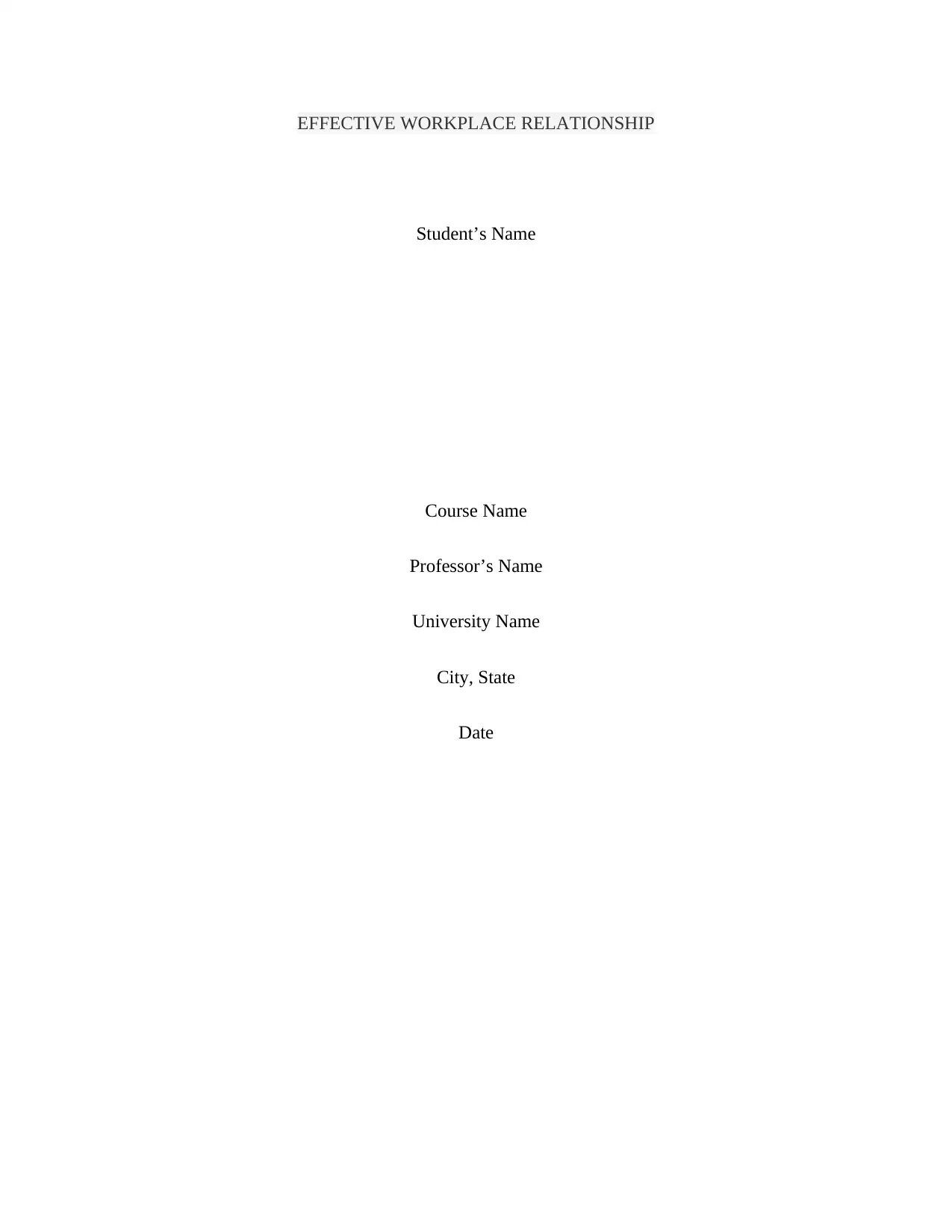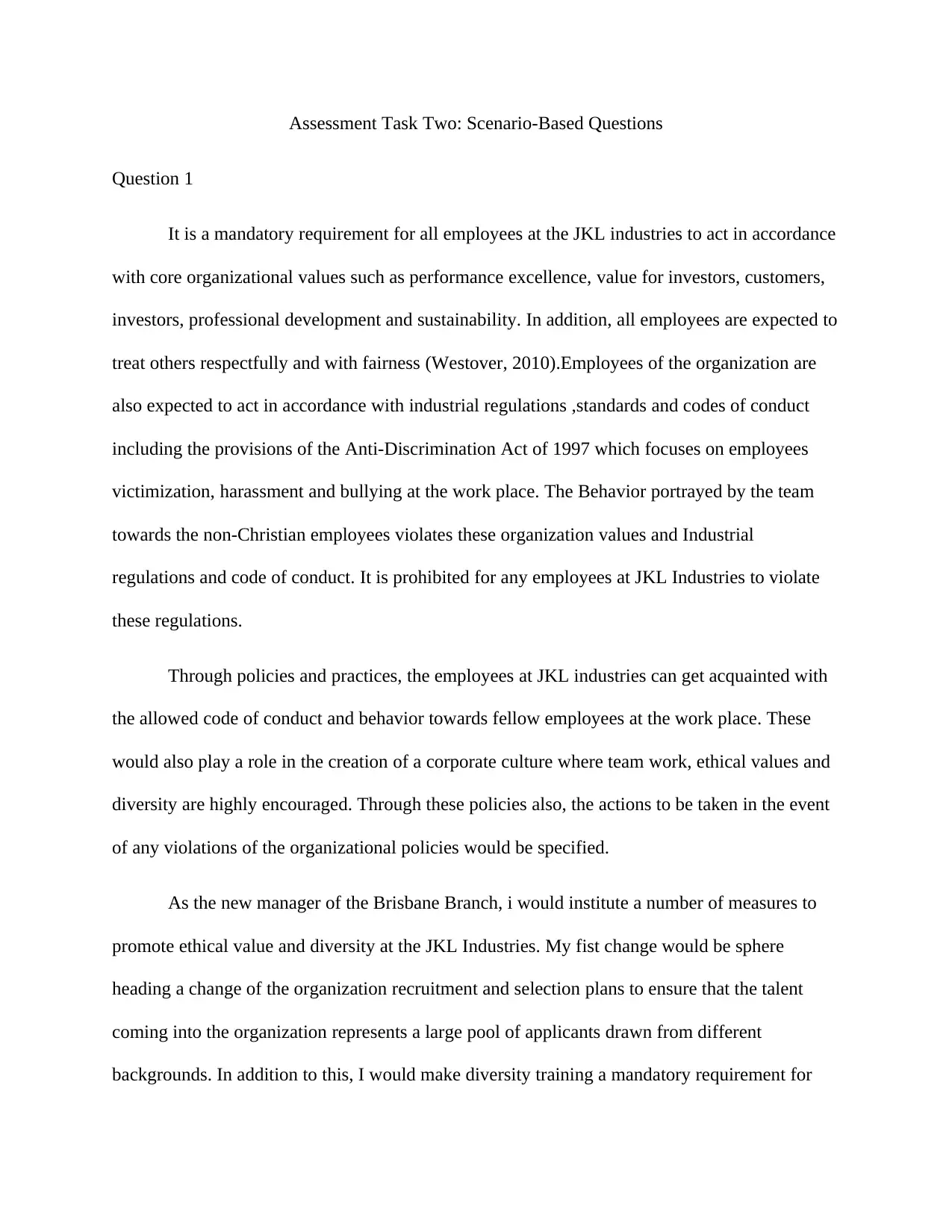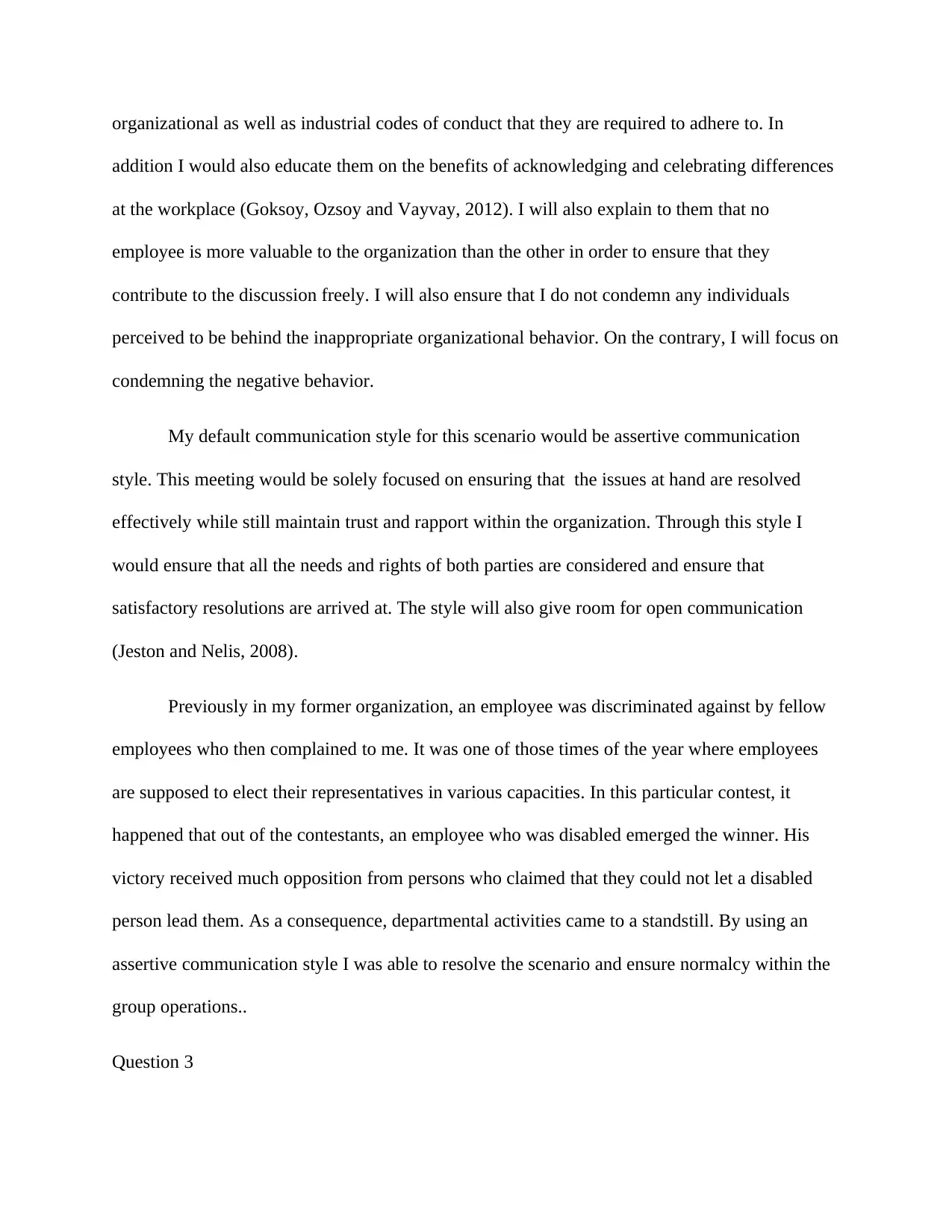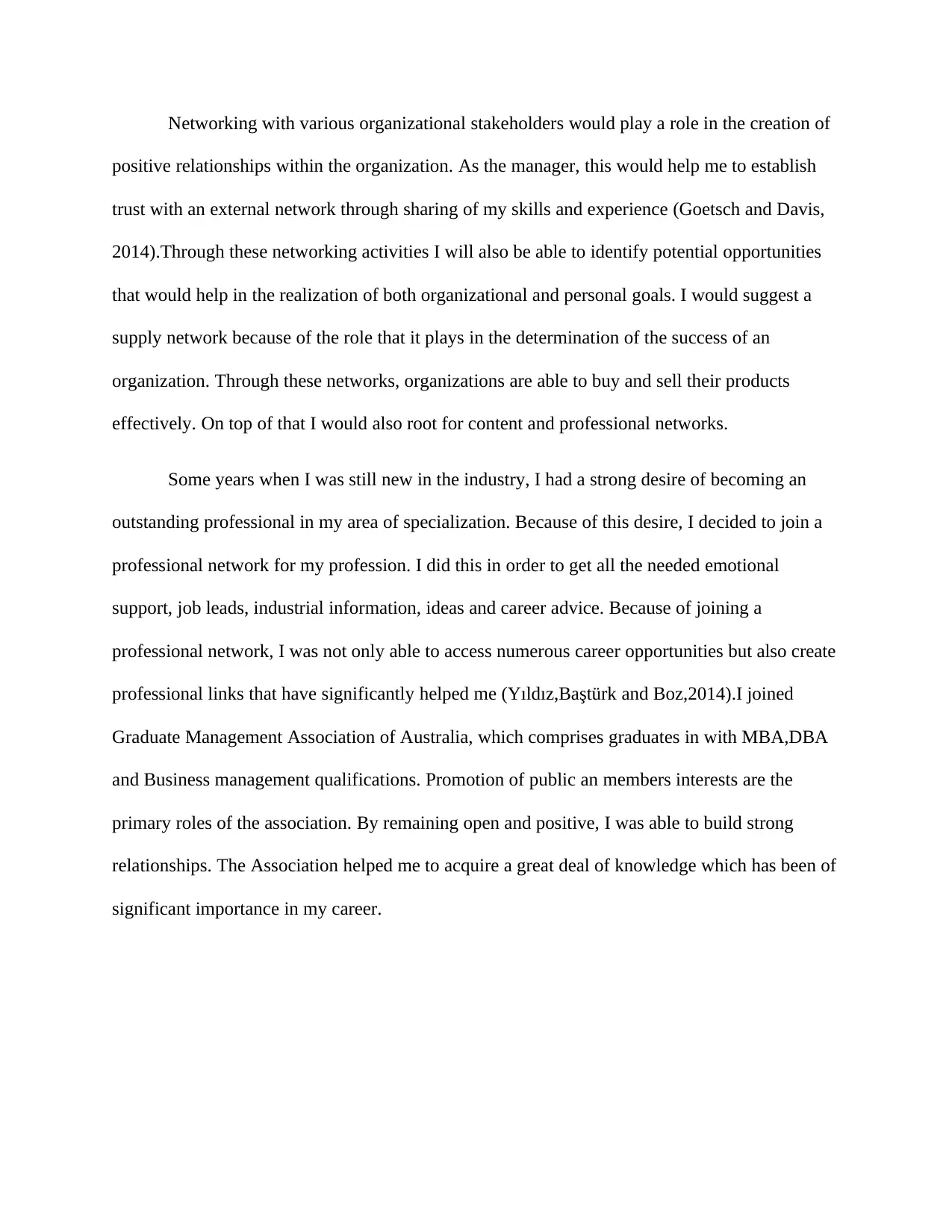Case Study: Effective Workplace Relationships and Diversity at JKL
VerifiedAdded on 2023/05/26
|6
|1496
|143
Case Study
AI Summary
This document presents a case study solution focused on promoting effective workplace relationships, ethical values, and diversity within JKL Industries. The solution addresses a scenario involving violations of organizational values and industrial regulations related to discrimination against non-Christian employees. It outlines measures to foster a corporate culture that values teamwork, ethics, and diversity, including changes to recruitment, mandatory diversity training, and the implementation of a written code of conduct. The solution also anticipates potential problems during team meetings and suggests an assertive communication style to resolve issues while maintaining trust and rapport. Furthermore, it emphasizes the importance of networking with organizational stakeholders to build positive relationships and identifies relevant professional networks for career development. The document concludes with references to support the proposed strategies and solutions. Students can find similar solved assignments and study resources on Desklib.

EFFECTIVE WORKPLACE RELATIONSHIP
Student’s Name
Course Name
Professor’s Name
University Name
City, State
Date
Student’s Name
Course Name
Professor’s Name
University Name
City, State
Date
Paraphrase This Document
Need a fresh take? Get an instant paraphrase of this document with our AI Paraphraser

Assessment Task Two: Scenario-Based Questions
Question 1
It is a mandatory requirement for all employees at the JKL industries to act in accordance
with core organizational values such as performance excellence, value for investors, customers,
investors, professional development and sustainability. In addition, all employees are expected to
treat others respectfully and with fairness (Westover, 2010).Employees of the organization are
also expected to act in accordance with industrial regulations ,standards and codes of conduct
including the provisions of the Anti-Discrimination Act of 1997 which focuses on employees
victimization, harassment and bullying at the work place. The Behavior portrayed by the team
towards the non-Christian employees violates these organization values and Industrial
regulations and code of conduct. It is prohibited for any employees at JKL Industries to violate
these regulations.
Through policies and practices, the employees at JKL industries can get acquainted with
the allowed code of conduct and behavior towards fellow employees at the work place. These
would also play a role in the creation of a corporate culture where team work, ethical values and
diversity are highly encouraged. Through these policies also, the actions to be taken in the event
of any violations of the organizational policies would be specified.
As the new manager of the Brisbane Branch, i would institute a number of measures to
promote ethical value and diversity at the JKL Industries. My fist change would be sphere
heading a change of the organization recruitment and selection plans to ensure that the talent
coming into the organization represents a large pool of applicants drawn from different
backgrounds. In addition to this, I would make diversity training a mandatory requirement for
Question 1
It is a mandatory requirement for all employees at the JKL industries to act in accordance
with core organizational values such as performance excellence, value for investors, customers,
investors, professional development and sustainability. In addition, all employees are expected to
treat others respectfully and with fairness (Westover, 2010).Employees of the organization are
also expected to act in accordance with industrial regulations ,standards and codes of conduct
including the provisions of the Anti-Discrimination Act of 1997 which focuses on employees
victimization, harassment and bullying at the work place. The Behavior portrayed by the team
towards the non-Christian employees violates these organization values and Industrial
regulations and code of conduct. It is prohibited for any employees at JKL Industries to violate
these regulations.
Through policies and practices, the employees at JKL industries can get acquainted with
the allowed code of conduct and behavior towards fellow employees at the work place. These
would also play a role in the creation of a corporate culture where team work, ethical values and
diversity are highly encouraged. Through these policies also, the actions to be taken in the event
of any violations of the organizational policies would be specified.
As the new manager of the Brisbane Branch, i would institute a number of measures to
promote ethical value and diversity at the JKL Industries. My fist change would be sphere
heading a change of the organization recruitment and selection plans to ensure that the talent
coming into the organization represents a large pool of applicants drawn from different
backgrounds. In addition to this, I would make diversity training a mandatory requirement for

both new and existing employees. This training would ensure that all employees understand and
appreciate individual differences. In order to ensure that employees appreciate their differences I
would also initiate events and programs and events such as seminars that would allow free
interactions of employees (Bush, 2008). I would also avail a written code of conduct to be
adhered to by all employees to ensure that ethical values are promoted at the JKL Industries. I
would also make sure that education programs centered on industrial regulation codes are rolled
out to all employees to improve their awareness and reduce instances of violations.
In order to ensure that issues at the JKL industries are effectively resolved, I would first
call a meeting with all the employees in which I would discuss the appropriate and inappropriate
code of conduct for an employee of the Company. In this meeting I will pointy out the issues that
have been raised by the non-Christian employees. In trying to addresses this issue my focus will
be on the entirely on the inappropriate behavior and not the employees involved. I would then
grant both parties an opportunity to be heard in order to get to the bottom of the problem and find
a lasting solution (Chung and Luo, 2008)
Question 2
Some of the problems that I anticipate from the team members are lack of openness and
unwillingness to contribute to the agenda of the meeting by some members. I also anticipate a
situation where some of the most active members of the group will be relied upon to come up
with the possible solutions for the current challenges. It is also possible that some of the
members may shift blame on others in the course of the meeting.
I would confront the team by first explaining to them why it is necessary for all
employees to carry themselves appropriately at the workplace. I would then teach them about
appreciate individual differences. In order to ensure that employees appreciate their differences I
would also initiate events and programs and events such as seminars that would allow free
interactions of employees (Bush, 2008). I would also avail a written code of conduct to be
adhered to by all employees to ensure that ethical values are promoted at the JKL Industries. I
would also make sure that education programs centered on industrial regulation codes are rolled
out to all employees to improve their awareness and reduce instances of violations.
In order to ensure that issues at the JKL industries are effectively resolved, I would first
call a meeting with all the employees in which I would discuss the appropriate and inappropriate
code of conduct for an employee of the Company. In this meeting I will pointy out the issues that
have been raised by the non-Christian employees. In trying to addresses this issue my focus will
be on the entirely on the inappropriate behavior and not the employees involved. I would then
grant both parties an opportunity to be heard in order to get to the bottom of the problem and find
a lasting solution (Chung and Luo, 2008)
Question 2
Some of the problems that I anticipate from the team members are lack of openness and
unwillingness to contribute to the agenda of the meeting by some members. I also anticipate a
situation where some of the most active members of the group will be relied upon to come up
with the possible solutions for the current challenges. It is also possible that some of the
members may shift blame on others in the course of the meeting.
I would confront the team by first explaining to them why it is necessary for all
employees to carry themselves appropriately at the workplace. I would then teach them about
⊘ This is a preview!⊘
Do you want full access?
Subscribe today to unlock all pages.

Trusted by 1+ million students worldwide

organizational as well as industrial codes of conduct that they are required to adhere to. In
addition I would also educate them on the benefits of acknowledging and celebrating differences
at the workplace (Goksoy, Ozsoy and Vayvay, 2012). I will also explain to them that no
employee is more valuable to the organization than the other in order to ensure that they
contribute to the discussion freely. I will also ensure that I do not condemn any individuals
perceived to be behind the inappropriate organizational behavior. On the contrary, I will focus on
condemning the negative behavior.
My default communication style for this scenario would be assertive communication
style. This meeting would be solely focused on ensuring that the issues at hand are resolved
effectively while still maintain trust and rapport within the organization. Through this style I
would ensure that all the needs and rights of both parties are considered and ensure that
satisfactory resolutions are arrived at. The style will also give room for open communication
(Jeston and Nelis, 2008).
Previously in my former organization, an employee was discriminated against by fellow
employees who then complained to me. It was one of those times of the year where employees
are supposed to elect their representatives in various capacities. In this particular contest, it
happened that out of the contestants, an employee who was disabled emerged the winner. His
victory received much opposition from persons who claimed that they could not let a disabled
person lead them. As a consequence, departmental activities came to a standstill. By using an
assertive communication style I was able to resolve the scenario and ensure normalcy within the
group operations..
Question 3
addition I would also educate them on the benefits of acknowledging and celebrating differences
at the workplace (Goksoy, Ozsoy and Vayvay, 2012). I will also explain to them that no
employee is more valuable to the organization than the other in order to ensure that they
contribute to the discussion freely. I will also ensure that I do not condemn any individuals
perceived to be behind the inappropriate organizational behavior. On the contrary, I will focus on
condemning the negative behavior.
My default communication style for this scenario would be assertive communication
style. This meeting would be solely focused on ensuring that the issues at hand are resolved
effectively while still maintain trust and rapport within the organization. Through this style I
would ensure that all the needs and rights of both parties are considered and ensure that
satisfactory resolutions are arrived at. The style will also give room for open communication
(Jeston and Nelis, 2008).
Previously in my former organization, an employee was discriminated against by fellow
employees who then complained to me. It was one of those times of the year where employees
are supposed to elect their representatives in various capacities. In this particular contest, it
happened that out of the contestants, an employee who was disabled emerged the winner. His
victory received much opposition from persons who claimed that they could not let a disabled
person lead them. As a consequence, departmental activities came to a standstill. By using an
assertive communication style I was able to resolve the scenario and ensure normalcy within the
group operations..
Question 3
Paraphrase This Document
Need a fresh take? Get an instant paraphrase of this document with our AI Paraphraser

Networking with various organizational stakeholders would play a role in the creation of
positive relationships within the organization. As the manager, this would help me to establish
trust with an external network through sharing of my skills and experience (Goetsch and Davis,
2014).Through these networking activities I will also be able to identify potential opportunities
that would help in the realization of both organizational and personal goals. I would suggest a
supply network because of the role that it plays in the determination of the success of an
organization. Through these networks, organizations are able to buy and sell their products
effectively. On top of that I would also root for content and professional networks.
Some years when I was still new in the industry, I had a strong desire of becoming an
outstanding professional in my area of specialization. Because of this desire, I decided to join a
professional network for my profession. I did this in order to get all the needed emotional
support, job leads, industrial information, ideas and career advice. Because of joining a
professional network, I was not only able to access numerous career opportunities but also create
professional links that have significantly helped me (Yıldız,Baştürk and Boz,2014).I joined
Graduate Management Association of Australia, which comprises graduates in with MBA,DBA
and Business management qualifications. Promotion of public an members interests are the
primary roles of the association. By remaining open and positive, I was able to build strong
relationships. The Association helped me to acquire a great deal of knowledge which has been of
significant importance in my career.
positive relationships within the organization. As the manager, this would help me to establish
trust with an external network through sharing of my skills and experience (Goetsch and Davis,
2014).Through these networking activities I will also be able to identify potential opportunities
that would help in the realization of both organizational and personal goals. I would suggest a
supply network because of the role that it plays in the determination of the success of an
organization. Through these networks, organizations are able to buy and sell their products
effectively. On top of that I would also root for content and professional networks.
Some years when I was still new in the industry, I had a strong desire of becoming an
outstanding professional in my area of specialization. Because of this desire, I decided to join a
professional network for my profession. I did this in order to get all the needed emotional
support, job leads, industrial information, ideas and career advice. Because of joining a
professional network, I was not only able to access numerous career opportunities but also create
professional links that have significantly helped me (Yıldız,Baştürk and Boz,2014).I joined
Graduate Management Association of Australia, which comprises graduates in with MBA,DBA
and Business management qualifications. Promotion of public an members interests are the
primary roles of the association. By remaining open and positive, I was able to build strong
relationships. The Association helped me to acquire a great deal of knowledge which has been of
significant importance in my career.

References
Bush, T., 2008. From management to leadership: semantic or meaningful change?. Educational
Management Administration & Leadership, 36(2), pp.271-288.
Chung, C.N. and Luo, X., 2008. Human agents, contexts, and institutional change: The decline
of the family in the leadership of business groups. Organization Science, 19(1), pp.124-142.
Goetsch, D.L. and Davis, S.B., 2014. Quality management for organizational excellence. Upper
Saddle River, NJ: pearson.
Goksoy, A., Ozsoy, B. and Vayvay, O., 2012. Business process reengineering: a strategic tool for
managing organizational change an application in a multinational company. International
Journal of Business and Management, 7(2), p.89.
Jeston, J. and Nelis, J., 2008. Business Process Management: Practical Guidelines to Successful
Implementations.
Westover, J.H., 2010. Managing organizational change: Change agent strategies and techniques
to successfully managing the dynamics of stability and change in organizations — International
Journal of Management & Innovation, 2(1).
Yıldız, S., Baştürk, F. and Boz, İ.T., 2014. The effect of leadership and innovativeness on
business performance. Procedia-Social and Behavioral Sciences, 150, pp.785-793.
Bush, T., 2008. From management to leadership: semantic or meaningful change?. Educational
Management Administration & Leadership, 36(2), pp.271-288.
Chung, C.N. and Luo, X., 2008. Human agents, contexts, and institutional change: The decline
of the family in the leadership of business groups. Organization Science, 19(1), pp.124-142.
Goetsch, D.L. and Davis, S.B., 2014. Quality management for organizational excellence. Upper
Saddle River, NJ: pearson.
Goksoy, A., Ozsoy, B. and Vayvay, O., 2012. Business process reengineering: a strategic tool for
managing organizational change an application in a multinational company. International
Journal of Business and Management, 7(2), p.89.
Jeston, J. and Nelis, J., 2008. Business Process Management: Practical Guidelines to Successful
Implementations.
Westover, J.H., 2010. Managing organizational change: Change agent strategies and techniques
to successfully managing the dynamics of stability and change in organizations — International
Journal of Management & Innovation, 2(1).
Yıldız, S., Baştürk, F. and Boz, İ.T., 2014. The effect of leadership and innovativeness on
business performance. Procedia-Social and Behavioral Sciences, 150, pp.785-793.
⊘ This is a preview!⊘
Do you want full access?
Subscribe today to unlock all pages.

Trusted by 1+ million students worldwide
1 out of 6
Related Documents
Your All-in-One AI-Powered Toolkit for Academic Success.
+13062052269
info@desklib.com
Available 24*7 on WhatsApp / Email
![[object Object]](/_next/static/media/star-bottom.7253800d.svg)
Unlock your academic potential
Copyright © 2020–2025 A2Z Services. All Rights Reserved. Developed and managed by ZUCOL.





